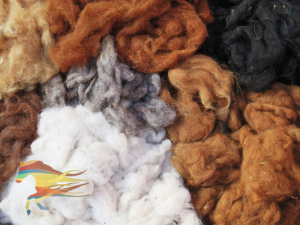

When considering your farm marketing strategy for your wool business, you may end up focusing on tactical aspects such as what to post on social media and forget to consider your wider farm marketing strategy. It is also easy to overlook elements of your business that contribute to your marketing strategy.

The 4Ps of marketing is a marketing idea that is built on the idea of having different elements of a marketing mix and needing to get this mix correct for successful marketing. The idea first arose in the 1960s and has since been developed. The 4Ps are:
You will need to consider each of these elements when planning any farm marketing strategy. You can think of this as a checklist for planning your farm marketing activities, but to go a step further in this blog, I have broken these 4Ps into various questions to help ensure you don’t miss anything.
 Who is your ideal customer?
Who is your ideal customer?An ideal customer also called an ICA, is your image or description of your perfect customer. This is not to say that these will be your only customers, but these are the customers that you should focus on, the ones you should market to and the ones that will make your business a success.
We often deal with farmers who view everyone as their customers, and although we understand that view, it is simply not effective when selling or marketing online.
Your ideal client should be the customer who you most like working with, the one that makes you the most profit, and the one who best fits your overall ethos for the business. Picture your best client, the one that really values what you do, never quibbles on price and is an advocate for your business.
Consider why this ideal client particularly values your product. If you want to dig deeper into how you develop an ICA and how to work out what makes them tick, then check out our free farm marketing strategy workbook here.
This question relates to the place part of the marketing mix as you think about where and how your customers will interact with you and therefore where your product will be found or positioned.
You need to think about where your ideal customer is likely to “hang out”, and consider the following questions:
The social media you choose will depend on your ideal customer and the platforms they most like to engage with, but for most wool businesses, Instagram and/or Facebook are likely to be the most appropriate option/s.
appropriate option/s.
Instagram is a good choice of social media platform for wool businesses for a few reasons. Firstly, its reliance on visual content means that businesses that take regular good quality images will do well, and wool businesses are ideally placed to benefit from this. Secondly, Instagram is home to a large crafting community who are highly engaged and often work collaboratively as a community. This offers an ideal setting for smaller businesses to thrive as a culture of supportive and ethical buying already exists.
To read more on using Instagram for your wool business, click here.
Facebook is now a harder platform to gain organic growth through, and the use of some paid advertising is likely to be important in generating success on Facebook. However, Facebook has been investing heavily in its “groups” technology, and this can be an effective way around the lost organic growth for business pages.
Once you have found one or more groups that have a high density of your ideal client, you need to check if you can join them as a business page. If you can then get in there, but if not, you need to consider whether you could join as your personal profile or not. If you also have an interest in the topic, then it may be worth joining as an individual, but consider if this will look professional enough for your farm business.
As a wool business, joining as an individual may suit you if you are the figurehead of the business and like to engage in those groups personally. However, this should be carefully considered.
To read more on using Facebook groups for farm marketing, check out this blog.
 The key to successful email marketing is having the right audience, so for some businesses, developing an email marketing list can be difficult. Ideally, you need to be able to capture customers’ details at every purchase.
The key to successful email marketing is having the right audience, so for some businesses, developing an email marketing list can be difficult. Ideally, you need to be able to capture customers’ details at every purchase.
Email marketing works best when your audience feel like they are treated as VIPs. Ideally, you want to ensure you can record as much data about each contact’s preferences as possible. For example, if you are a yarn business that produces yarns in different fibres, try to record which fibre each contact has a preference for. There is no point in marketing a new wool yarn to a contact who is allergic to wool, for example.
Email marketing should focus on increasing engagement and building relationships with your audience initially. Then, once you have that data and relationship, you can use that to cross or upsell products to your audience. For example, if you know they have recently bought a specific product, you can send them an offer for a complementary product or service.
Read more on email marketing here.
As you are planning how your customers will interact with your wool business, you may begin to consider if your business needs a website. Many people will simply set up a website without first considering if this is needed and what the goals of the website are. For example, if you are creating the website simply to process sales and payments, a landing page may be sufficient.
If you are unsure whether your wool business needs a website, check out this blog.
The usefulness of a website relies on customers being able to find your website and benefit from accessing it. To ensure your website is visible, you need to consider the role of search engine optimisation (SEO). There are lots of small things you can do to improve your own SEO, but at some point, you are likely to need some expert help in this area.
To find out more about SEO, check out this blog.
Writing blogs for your website is one of the best and easiest ways to improve your online visibility for your wool business. It is also an effective way of encouraging your customer to linger on your site and visit it regularly as they benefit from the blog content rather than simply visiting the site when they want to make a purchase.
This blog gives you 13 ideas for blogs you can write for your wool business.
When planning your farm marketing strategy for your wool business, you need to consider how you want to present your product to the public. A large part of this decision is how you price your products. I would recommend working out the absolute minimum pricing that works for your products – the amount you have to get to break even – then add between 5–10% depending on your farm diversification structure. This price is your baseline: the one that you use to ensure, even when on offer or sale, your products are still profitable.
Next, look to competitors to consider their pricing options and make a list of suitable comparisons to give you an idea of market value. Interestingly, when I recently visited a yarn festival event, almost every stand was selling artisan hand dyed yarn for between £18–22/100g. This is a very tight pricing range considering the range of yarn types, fibres and styles.
As a wool business, you may also need to consider how your pricing will differ depending on the buyer. For example, if you choose to sell direct to consumers and also be stocked in retail spaces, you will need to consider different pricing for the wholesalers and ensure the price the customer pays in both locations is fair and at least similar.
Try some of the questions below to get you started:
You will also need to think about packaging. When considering packaging, you need to balance practicality with design. Your packaging should support your farm marketing and brand development.
Your style of packaging will also affect the look and feel of your product, which helps to indicate your price point to consumers. You will notice higher-end brands tend to use colours such as black, gold/silver, and rich tones such as purples. These colours are associated with luxury, which helps to position the products in their pricing. Similarly, bright red, white and yellow are often associated with cheaper or lower-end products.
Equally, some visual cues remind customers of specific values you may have as a business; green or natural toned packaging is often associated with eco-friendly or natural products. The key here is that your packaging matches your ideal customer and the type of market you are trying to target. In the yarn market, there is often a trend towards recycled or sustainable packaging, such as card.